Related Research Articles

In Norse mythology, Sleipnir is an eight-legged horse ridden by Odin. Sleipnir is attested in the Poetic Edda, compiled in the 13th century from earlier traditional sources, and the Prose Edda, written in the 13th century by Snorri Sturluson. In both sources, Sleipnir is Odin's steed, is the child of Loki and Svaðilfari, is described as the best of all horses, and is sometimes ridden to the location of Hel. The Prose Edda contains extended information regarding the circumstances of Sleipnir's birth, and details that he is grey in color.

Ragnar Lodbrok, according to legends, was a Viking hero and a Swedish and Danish king. He is known from Old Norse poetry of the Viking Age, Icelandic sagas, and near-contemporary chronicles. According to traditional literature, Ragnar distinguished himself by conducting many raids against the British Isles and the Holy Roman Empire during the 9th century. He also appears in Norse legends, and according to the legendary sagas Tale of Ragnar's Sons and a Saga about Certain Ancient Kings, Ragnar Lodbrok's father has been given as the legendary king of the Swedes, Sigurd Ring.
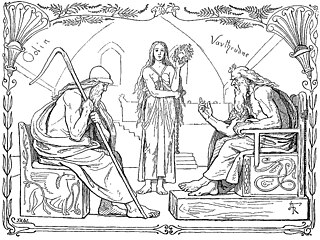
Vafþrúðnir is a wise jötunn in Norse mythology. His name comes from Vaf, which means weave or entangle, and thrudnir, which means strong or mighty. Some interpret it to mean "mighty in riddles". It may be anglicized Vafthruthnir or Vafthrudnir. In the Poetic Edda poem Vafþrúðnismál, Vafþrúðnir acts as Odin's host and opponent in a deadly battle of wits that results in Vafþrúðnir's defeat.
In Norse mythology, Dellingr is a god. Dellingr is attested in the Poetic Edda, compiled in the 13th century from earlier traditional sources, and in the Prose Edda, written in the 13th century by Snorri Sturluson. In both sources, Dellingr is described as the father of Dagr, the personified day. The Prose Edda adds that, depending on manuscript variation, he is either the third husband of Nótt, the personified night, or the husband of Jörð, the personified earth. Dellingr is also attested in the legendary saga Hervarar saga ok Heiðreks. Scholars have proposed that Dellingr is the personified dawn and his name may appear both in an English surname and place name.
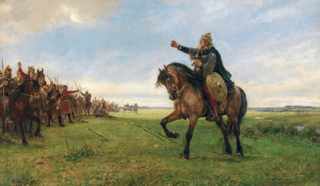
Hlöðskviða, known in English as The Battle of the Goths and Huns and occasionally known by its German name Hunnenschlachtlied, is an Old Norse heroic poem found in Hervarar saga ok Heiðreks. Many attempts have been made to try to fit it with known history, but it is an epic poem, telescoping and fictionalising history to a large extent; some verifiable historical information from the time are place names, surviving in Old Norse forms from the period 750–850, but it was probably collected later in Västergötland.
Various gods and men appear as sons of Odin or sons of Wodan/Wotan/Woden in old Old Norse and Old High German and Old English texts.
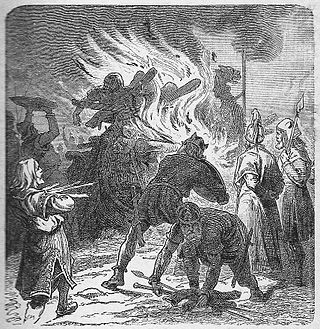
Sigurd Ring according to legend was a king of the Swedes, being mentioned in many old Scandinavian sagas. According to these sources he was granted rulership over Sweden as a vassal king under his uncle Harald Wartooth. Later he would take up arms against his uncle Harald in a bid to overthrow him and take the crown of Denmark, a conflict which Sigurd eventually won after the legendary Battle of the Brávellir, where it is said that Odin himself intervened and killed Harald. In the Sagas, Sigurd is also known for being the father of the Norse Viking hero and legendary king of Denmark and Sweden, Ragnar Lodbrok. According to Bósa saga ok Herrauds, there was once a saga on Sigurd Ring, but this saga is now lost.

Harald Wartooth or Harold Hiltertooth was a semi-legendary king of Denmark who is mentioned in several traditional sources. He is held to have (indirectly) succeeded his father as king of Zealand and to have expanded his realm. According to different sources, he may have ruled over Jutland, part of Sweden and the historical northern German province of Wendland. He is said to have been finally defeated and killed at the legendary Battle of Bråvalla.
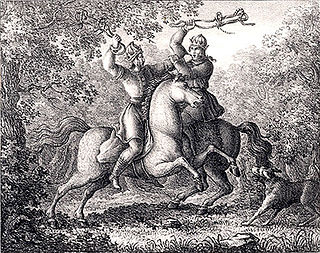
Alaric and Eric, according to legend, were two kings of Sweden.
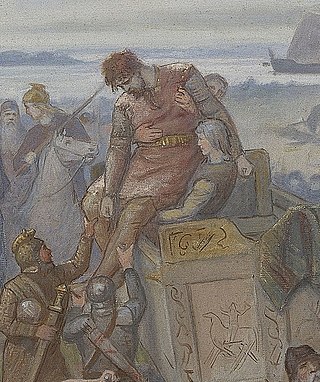
Styrbjörn the Strong according to late Norse sagas was a son of the Swedish king Olof, and a nephew of Olof's co-ruler and successor Eric the Victorious, who defeated and killed Styrbjörn at the Battle of Fyrisvellir. As with many figures in the sagas, doubts have been cast on his existence, but he is mentioned in a roughly contemporaneous skaldic poem about the battle. According to legend, his original name was Björn, and Styr-, which was added when he had grown up, was an epithet meaning that he was restless, controversially forceful and violent.

The Battle of Brávellir or the Battle of Bråvalla was a legendary battle, said to have taken place c.770, that is described in the sagas as taking place on the Brávellir between Sigurd Hring, king of Sweden and the Geats of Västergötland, and his uncle Harald Wartooth, king of Denmark and the Geats of Östergötland.

The House of Munsö, also called the House of Björn Ironside, the House of Uppsala or simply the Old dynasty, is the earliest reliably attested royal dynasty of Sweden, ruling during the Viking Age. None of the names suggested for the dynasty are universally accepted and most are problematic; the name "House of Munsö" derives from a questionable and speculative theory that they would have ruled from the island of Munsö and the name "House of Björn Ironside" derives from the supposed founder of the dynasty, Björn Ironside, who is often seen as a legendary, rather than historical, figure.

Hervarar saga ok Heiðreks is a legendary saga from the 13th century combining matter from several older sagas in Germanic heroic legend. It tells of wars between the Goths and the Huns during the 4th century. The final part of the saga, which was likely composed separately from and later than the rest, is a source for Swedish medieval history.

A shield-maiden was a female warrior from Scandinavian folklore and mythology.
Heidrek or Heiðrekr is one of the main characters in the cycle about the magic sword Tyrfing. He appears in the Hervarar saga, and probably also in Widsith, together with his sons Angantyr (Incgentheow) and Hlöð (Hlith), and Hlöð's mother Sifka (Sifeca). The etymology is heiðr, meaning "honour", and rekr, meaning "ruler, king".

Arngrim was a berserker, who features in Hervarar saga, Gesta Danorum, Lay of Hyndla, a number of Faroese ballads and Orvar-Odd's saga in Norse mythology.
The Tyrfing Cycle is a collection of Norse legends, unified by the shared element of the magic sword Tyrfing. Two of the legends are found in the Poetic Edda, and the Hervarar saga can be seen as a compilation of these legends.
Guðmundr was a semi-legendary Norse king in Jotunheim, ruling over a land called Glæsisvellir, which was known as the warrior's paradise.
Four Hang; Two Point the Way is the name given by the folklorist Archer Taylor to a traditional riddle-type noted for its wide international distribution. The most common solution is 'cow', and in Taylor's view 'we can probably infer that a cow was the original answer'.
The riddles of Hervarar saga ok Heiðreks, also known as Gátur Gestumblinda and Heiðreks gátur, are a group of around thirty-seven Old Icelandic verse riddles that constitute the main evidence for medieval Scandinavian riddling. They appear in Hervarar saga ok Heiðreks as part of a riddle-contest in which the god Óðinn, disguised as a man called Gestumblindi, propounds riddles to the saga's protagonist, Heiðrekr. In the estimation of Jeffrey Scott Love in 2013, they 'have received more scholarly attention than any other passage in the text'.
References
- 1 2 'Hervarar saga ok Heiðreks', ed. by Hannah Burrows, in Poetry in 'Fornaldarsögur': Part 1, ed. by Margaret Clunies Ross, Skaldic Poetry of the Scandinavian Middle Ages, 8 (Turnhout: Brepols, 2017), pp. 367-487.
- ↑ Christopher Tolkien (ed. and trans.), The Saga of King Heidrek the Wise (London: Nelson, 1960), pp. 30–44 (chs 8–9).
- ↑ Jeffrey Scott Love, The Reception of 'Hervarar saga ok Heiðreks' from the Middle Ages to the Seventeenth Century, Münchener Nordistische Studien, 14 (Munich: Utz, 2013); ISBN 978-3-8316-4225-0.